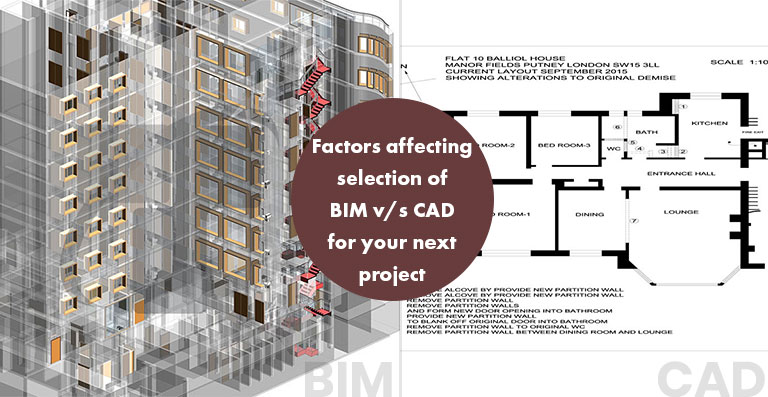Factors affecting selection of BIM v/s CAD for your next project

It was in 1970s that Computer aided design or CAD came into the market, following which it has been an invaluable tool to the designers helping them in designing various parts and components. CAD has evolved over the years and is today a sophisticated program capable of creating extremely detailed 2D and 3D models.
When it comes to the construction industry new concepts are being introduced regularly which automates and augments the whole building process. BIM is one of the new concepts quickly taking over the construction industry. BIM is a process and methodology by which a team of architects, engineers and contractors work collaboratively to build on coordinated, reliable information about the project.
Today, the professionals may face a dilemma when it comes to choosing a software since, CAD and BIM both have its own share of advantages and disadvantages which need to be considered. Below we look at both CAD and BIM in detail, and which software to choose when.
What is CAD?
CAD or Computer-Aided Design involves the use of computers for creating designs and documents related to construction projects. Initially CAD was concerned with 2D CAD drawings of things such as floor plans, elevation etc. but today it has evolved to keep up with the changes in the construction industry and allows to create accurate 3D representations of the building and facilities. Today CAD Services can be utilized to create preliminary designs and layouts, accomplish design details and calculations, as well as create 3-D models. CAD also aids with analysis, marketing and can be combined with rendering to provide photorealistic images of the design.
What is the BIM?
BIM at its core is a digital representation of the actual building, including functional systems and aesthetics. A BIM model made from all the relevant information regarding the project, allows for creation, modification and monitoring of the whole construction project. It also enables seamless management and enables sharing of data easily to all the stakeholders. The intelligent 3D model also allows for clash detection to make sure the end model is error free. Finally, BIM can also be combined with other dimensions like 4D(schedule), 5D(cost), 6D(sustainability) and 7D (facility management).
What are the similarities between CAD and BIM?
CAD and BIM do have certain similarities which initially creates a predicament for the professionals choosing either of them. Firstly, even though there is 2D CAD, both are capable of 3D modelling. Moreover, both CAD and BIM are prominently used in the AEC industry to create reliable, accurate models. They both also allow for documentation which can be used for on-site construction. Finally, both requires considerable skill and expertise to operate and reduces errors, waste of time and materials and overall benefits the construction process.
What are the differences between CAD and BIM?
More than the similarities however, the differences between CAD and BIM are noteworthy. The main difference lies with regards to the designing techniques. CAD involves line- to-line designs where BIM focuses on parameters to design full 3D models. In BIM all lines are connected in the model which makes it easy to make any modifications. Also in BIM there is a synchronization between all the drawings such as plans, elevations, sections etc. Since all these drawings are extracted from one BIM model, any change in the design of 3D model will model will automatically result in the updating in all the drawings that are extracted.
Visualization is also different with BIM. BIM models can be zoomed in on and out of, expanded, contracted, and so on while CAD is more static. Another difference which is noteworthy is the amount of information that can be managed by BIM. BIM models are information rich, they provide details about material quantities, schedules, manufacture’s details etc. This also saves a lot of time since everything that is required with regards to the construction can be extracted from the BIM model.
In BIM all multidisciplinary models are combined in one model making it possible to detect any clashes right at the planning stage. Moreover, with conflict control tools like Navisworks appropriate tolerances can be set and relevant clashes can be detected.
BIM or CAD — Which to Use?
Weather the AEC firm chooses to go with BIM or CAD depends on each individual project. 2D CAD is slowly becoming obsolete as contractors and designers are today looking for 3D visualization. In general, the question is whether to choose BIM or 3D CAD. Looking at the above advantages like interference checking, virtual collision detection, forecasting construction related issues etc. BIM might be a better choice.
Another thing to consider is the scope of Work and Budget. When the scope of work of the project is small and more confined to one field of construction like the architectural field then designer might choose to go with CAD. However, in bigger projects with many disciplines involved going the BIM way will prove to simpler and more time saving. CAD software might be cheaper as compared to BIM, and sometimes that might seem that CAD is economical but with the precision and accuracy that BIM allows over CAD it may end up being more cost effective in the long run. Finally, the designer’s skill level with a particular software, the level of comfort and speed with the particular software also makes a difference in weather BIM or CAD is incorporated. However, the ideal practice would be to know the project requirements then make a choice or to simply outsource it to a reliable BIM Service provider or a CAD Company.
Final Thoughts:
Thus, there are clear distinctions between BIM and CAD solutions. By understanding these differences and similarities between them the designer, architect or the engineer can make an informed decision about whether to choose BIM or CAD.
